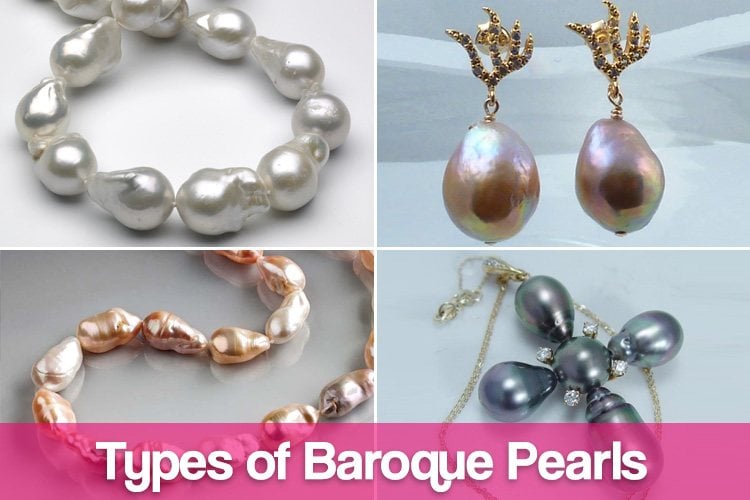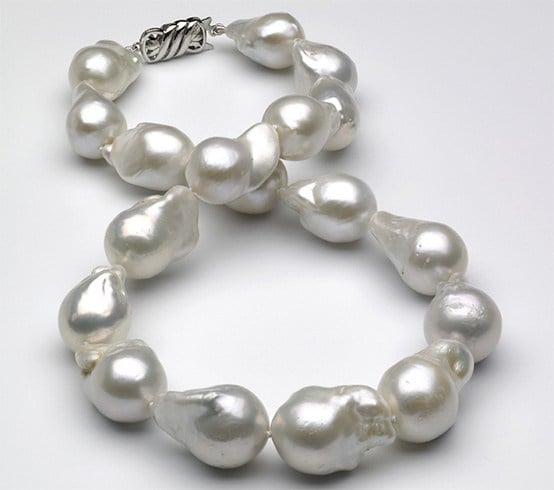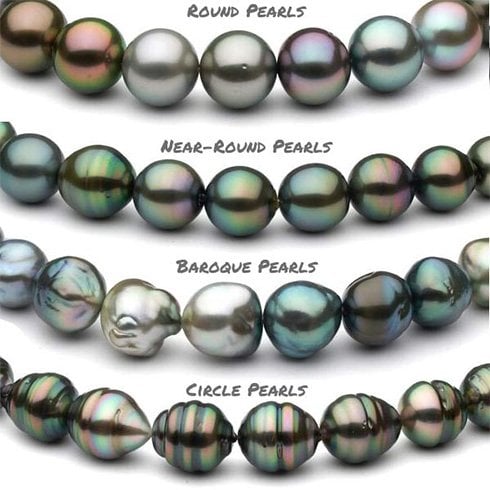
Every jewelry-loving lady knows and loves pearls. They look elegant, graceful, sophisticated, and charming when round-shaped. But when they have an “irregular” shape, they are considered as Baroque Pearls.
Hope you got the Baroque pearls meaning, to start with.
Types of Baroque Pearls:
The freshwater baroque pearls are the most common type. Since less than 10 percent of freshwater pearls are round, it certainly means that the vast majority of these pearls are baroque in looks and nature.

Source: americanpearl.com
Freshwater pearls are not the be-all in baroque pearls. Saltwater pearls, and cultured and natural ones, also come in baroque shapes. Even Akoya pearls that are known for their perfectly round shapes have baroque shapes.

Source: americanpearl.com
Shapes of Baroque Pearls:
Baroque pearls have different subtypes. While all of them are “deformed,” some of them stand out for their distinctive features. Let us get an idea of how vast the category is of baroque pearls jewelry. You will love it for sure!
Coin Pearls:
A subtype of baroque pearls, coin pearls refer to the round and flat shape of these pearls. Their surface is smooth, no doubt. Another quality of coin-shaped baroque pearls is that they are able to reflect light because they have a larger flat surface than other types. That is why they come with a spectacular luster. In the jewelry making business, coin pearls enjoy massive appreciation because they can be used in the making of baroque pearl necklaces or baroque pearl earrings.

Source: pinterest.com/wendyarhontesdi/pearls
Baroque Pearls:
We are talking of Baroque pearls that are not round in shape, so how can this be a subtype. Confused, right? The truth is that a baroque pearl is also a sub-type. They stand out for their asymmetrical shape and their surface is uneven and dented.
Interestingly, baroque pearls were massively used in Victorian and Art Nouveau pieces.

Source: stauer.com
Tahitian Pearls:
The Baroque Tahitian pearls are exotic “black pearls” or stuff legends are made of. First, they are not grown in Tahiti (I knew you would be guessing Tahiti as the place of origin of these pearls) but in French Polynesia. Secondly, black is not the actual color of Tahitian pearls, never a true black, but the dark color in the family of blue, purple, green, brown, silver. Thirdly, there is not a single shape of Tahitian pearls, but many shapes – it so happens that baroque pearl is one of the shapes.

Source: pearlsofjoy.com
Twin Pearls:
Twin means two. So twin pearls mean two pearls that have been fused together. They can have similar shapes or one of them might be larger than the other. Since they appear to be extremely elegant, they are ideal for baroque pearl stud earrings.

Source: abbeyforge.com
Cross Pearls:
As goes the name, this is a very special type of Baroque pearls jewelry. Well, cross pearls come in the shape of a “cross,” making them ideal for jewelry pieces with religious notes.

Source: belforantiques.com
Rice Pearls:
These are small baroque pearls, which have the shape of rice grains. They are similar to traditional pearls because of the fact that they are rounded, but remain imperfect, which is why they are categorized as baroque pearls. Drilled centrally, they are used for baroque necklaces and baroque bracelets.

Source: ozbeads.com.au
Egg Pearls:
No, this is not for your dining table but for your ears. As the name suggests, the shape of these type of baroque pearls resembles that of an egg (and greatly so). Which is why Egg Pearls have wide bottoms and narrow tops. In order to preserve and highlight their unique shape, egg pearls are usually drilled vertically.

Source: pearlsonly.com
Potato Pearls:
Start loving potato in pearl form because Potato Pearls are there to grace you in the form of baroque pearls jewelry. They are the smallest type of Baroque Pearls – small and often square, round, or lumpy, not elongated, like other baroque shaped pearls. This makes them ideal for baroque pearl bracelets and baroque pearl necklaces. Don’t you eat them, ok?

Source: etsystudio.com
Hey, you must be wondering what next in the list of baroque pearls, which resembles a food item? The next one has nothing to do with food, but with emotions.
Heart Pearls:
Just like coin pearls, heart-shaped baroque pearls are flat and are in the shape of a heart. They can be used to make pretty and romantic baroque pearl pendants.

Source: saybella.com.au
Teardrop Pearls:
This dainty looking pearl enjoys mammoth popularity due to its unique tear-drop shape. Extremely delicate it is and commonly used for making luxury earrings and fine jewelry.

Source: etsy.com
Leaf Pearls:
They are the thinnest of baroque shaped pearls and almost paper-thin. It is just that they have a very bumpy and uneven surface. Leaf pearls can be used in the making of a wide range of jewelry items such as bracelets, necklaces, and earrings.

Source: lido-collection.co.u
Keshi Pearls:
Welcome to the rarest of rare baroque pearls – the keshi pearls. They are small pearls formed as by-products of pearl cultivation when a bead nucleus gets rejected. They mainly appear to be elongated and have an extraordinary luster.

Source: sevenseaspearls.com
What is meant by large baroque pearls? Obviously, baroque pearls which are larger (in size).

Source: livemaster.com
Tips To Appreciate the Value of Baroque Pearls:
Yeah, it’s confirmed.
That the baroque pearls have unusual shapes.
There is a different way of interpreting the value of baroque pearls. Let us see what they are.
1. Type: One of the main factors that determine the value of baroque pearls is the type of pearl that appears as baroque shaped.
2. Shape: Baroque pearls are generally analyzed according to their particular shape. For instance, the most valuable baroque shaped pearls are Keshi pearls, baroque pearls and cross pearls.
3. Size: It is understood that the size of a pearl is (and will always) be important when it comes to determining its value. When it comes to classic pearls – the larger the pearl, the more valuable it is.
4. Color: When it comes to assessing the value, the color of the pearl plays a major role. Although most irregular-shaped pearls come in shades of white, salmon and pink, the dark-colored pearls are the most valuable ones. Guess why? Because they are extremely rare.
5. Luster: The luster of a pearl depends on how well it can reflect light. This is where coin pearls and Keshi pearls score the most as they give the maximum luster.
Now, you know all about the Baroque pearls. Let us know which type, size, and shape of baroque pearls fascinated you the most in the comments section below.

1 comment
I went to a market this past Saturday and purchase this three strand curls barge eggs with Krystal’s between them the larger the egg on the 3rd strand I believe they’re from the 50s I wish I could leave a photo and know the value